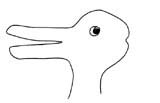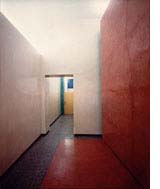GESTURE
EXTENSION PLAY:
A CONVERSATION CONCERNING THE NATURE OF TRANSFORMATION
THROUGH ART
ROGER SHEPHERD INTERVIEWS ROGER SHEPHERD
An image
must be transformed by contact with other images as is a color
by contact with other colors. A blue is not the same blue beside a green,
a yellow, a red.
No art without transformation. 1
–
Robert Bresson
Figure 1. The Spotted Ponies (detail), iron oxide on wall surface. Peche Merle, France, Upper Paleolithic Period (18,000 BC). Similar hand prints can be found as far back as 35,000 years ago.
Figure 2. Chinese fan, circa 1900. Brush and ink on rice paper, collection of the artist.
Figure 3. The "duck-rabitt" from Jastrow's Fact and Fable in Psychology (1900), redrawn by Ludwig Wittgenstein.
Figure 4. Seeing by means of visual rays, from Vignola, La due regole della prospettiva practica, 1611.
Figure 5. Roger Shepherd, untitled (bouche du rhône], 2000, gouache and ink over mounted etching.
Figure 6. Roger Shepherd, Lobby 588 Broadway, NYC, 1986. Tinted plaster (fresco), tinted portland cement, terrazzo, mirror, enameled metal, synthetic laminate, aluminum, and polished marble.
R: On a recent visit to MoMA I saw a visitor struggling to point out to a friend how nine squares make up a painting by Ad Reinhardt; it's not a single black surface. Meanwhile, the museum has so flooded the work with light that it can't be seen anyway–essentially the painting doesn't exist. I'm not sure what the couple finally saw, but at least they were trying.
r: But, say it were properly lit—is this what it all comes down to–finding the squares?
R: Of course not. When I said 'struggling' just now, I wasn't referring to problems with the light. No, it's really futile to find a painting's meaning in a way that dead-ends at a single point–as if art were a kind of parlor trick: once you get it, it's over. No need to think anymore.
r: Do you think this a problem with abstract art in particular, or the condition with contemporary art in general? Or, does it simply mean we don’t know how to talk about art anymore?
R: I'm not sure we ever did. Barnett Newman thought it was because we don't even try to get at the spirit in the work. He also felt the problem had worsened in modern times.
The failure of European art to achieve the sublime is due to [a] blind desire to exist inside the reality of sensation (the object world, whether distorted or pure) and to build an art within the framework of pure plasticity (the Greek ideal of beauty, whether that plasticity be a romantic active surface, or a classic stable one). In other words, modern art, caught without a sublime content, was incapable of creating a new sublime image, and unable to move away from the Renaissance imagery of figures and objects except by distortion or by denying it completely for an empty world of geometric formalisms–a pure rhetoric of abstract mathematical relationships, became enmeshed in a struggle over the nature of beauty; whether beauty was in nature or could be found without nature. 2
I think he oversimplifies a bit and justifies his own work in the process (what artist doesn't?), but he certainly doesn’t overstate the case about sensible objects and our mistaken notion that art is supposed to picture things.
r: He speaks of the sublime, is this what you think we should be talking about? Hasn't this become a bit quaint?
R: The sublime, whatever that may be, is not at issue. In fact, to talk about the sublime is impossible and consciously trying to paint the sublime is worse than pointless. No, the question raised by Newman's remarks is how do we get at this other stuff.
r: When it comes to art, has anyone ever said anything well?
R: Of course, but rarely in the realm of everyday discourse where it matters if art is to be meaningful for all of us. We rely too much on others to inform us as to what's good or bad, or to tell us what's art and what isn't. This leaves us pretty helpless, unfortunately.
r: What choice do we have? Where do we start?
R: With the work. From the beginning cave painters realized that the slightest scratch or spot of color added to a wall's face changes its space; every gesture seems to dematerialize the surface–we see beyond it. Simultaneously we get direction (top, bottom, left, right) and rhythm (relationships of size, similarity, difference, repetition). Meanwhile, the mark or the spot registers as some thing against a background or field, what we call a figure-ground or figure-field relationship. Mysteriously this field seems to lie beneath the figure, unbroken, within the space of the wall. All at once, every mark alters a wall; at the very origins of image-making the entire grammar of the visual arts was in place.
r: Aren't you talking about perception, though? Isn't it only natural to see things against a field?
R: It's normal–in the world. But we're talking about how images work–what I'm describing are changes taking place in us. These things resonate in the body as well as in the mind. For instance, in the case of the traced hands [figure 1], the wall, or ground becomes a hand (or figure) just as the pigmented spot (the original figure) turns into the ground. Once we see the hand, figure and ground switch places. And, meaning changes accordingly.
r: It's a kind of magic, I guess.
R: Yes, if it ended here, it would certainly be a trick, but it gets more complicated right away. Imagine, for instance, a Chinese brush painting of bamboo shoots and leaves [figure 2]. Flat shapes seem to have volume, leaves overlap leaves, and everything is wrapped in light and air. Now think about how many of these qualities you've supplied yourself, even the idea of color. Nothing is really pictured when you think about it–it's all an imagined extension of the world we know.
It doesn't stop there, either. A network of radiating lines crosses the fan's arc; they're the folds, now accentuated by wear and soiled through use. We mentally place these aside insofar as they are incidental to the image, but aren't they essential to our overall appreciation? Don't they even lend a certain beauty in spite of having been acquired with time? If they were removed would the image be the same?
r: But, isn't this all just automatic, like perspective, for instance?
R: Not really. Perspective is just one set of rules that began as a model for painting and became a model of the way we supposedly see. But, it depicts a world that never comes within reach–a space without time [figure 4]. Even the inventors of perspective saw the limits of its artifice, but the rest of the Western world was soon so convinced of its authority that we still can't shake ourselves from its grip. Relying instead on common sense, a thinker like Bishop Berkeley3 made a distinction between the visible and the tangible and showed how the visible is known through the tangible:
. . . we see both [distance and size] in the same way that we see shame or anger in the looks of a man. Those passions are themselves invisible; they are nevertheless let in by the eye along with colours and alternations of countenance, which are the immediate object of vision, and which signify them for no other reason, than barely because they have been observed to accompany them; without which experience, we should no more have taken blushing for a sign of shame, than of gladness [italics mine]. 4
Vision is selective. We touch the world and the world touches us. Now our Chinese painting goes by other rules, a product of an art of time as well as of space.
In the European tradition, the interest in measurable space destroyed the "continuous method" of temporal sequence used in the Middle Ages and led to the fifteenth century invention of the fixed space of scientific perspective. When the Chinese were faced with the same problem of spatial depth in the Yang period, they re-worked the early principles of time and suggested a space through which one might wander and a space which implied more space beyond the picture frame. We restricted space to a single vista as though seen through an open door; they suggested the unlimited space of nature as though they had stepped through that open door and had known the sudden breath-taking experience of space extending in every direction and infinitely into the sky. 5
r: Don't we need edges or boundaries for meaning?
R: We always supply them; rules change, but the game never does. This interchange between image and the world is nowhere so eloquently made clear than in photographs of Mondrian's last studio. He believed in links between society, art, and the role of the artist; between different arts (architecture, music, painting, literature); and between art and life. He arranged and rearranged his studio during what he called 'periods of rest.' The studio served as an incubator for ideas, a laboratory for his art and his life.
I once designed an entire space inspired by these photographs, among other things [figure 6]. There are places within my piece, that though they seem neutral, are designed–everything is designed. The spaces between are purposely smoothed back into the environment, just so they may be pulled out again by the work we do to look at it.
r: What do you mean by 'smoothed back'?
R: The fire door is a good example. There are legal requirements. It had to be metal. It therefore had to be enameled. I chose yellow, but I mixed a color that is not the standard. It's an important part of the work. It's also a yellow fire door. My piece mixes the spatial play of Borromini, the classical picture plane experiments of Brunelleschi, and even the writings of Borges, while bringing it all to bear on the current conditions of Broadway and the grid of the island of Manhattan. And, we see the city streets differently when we emerge.
Language is such that we keep saying out of habit, look this happens here, or that occurs over there. But, without interaction the object just sits there–mute. Ah, but when we pay attention . . . then the space in a painting by Cézanne, for instance, goes into contortions, twisting and multiplying the point of traditional perspective until it more faithfully resembles the act of seeing itself. It's when we notice things that transformation takes place. The moment of recognition is dispositional,6 a fancy word that can refer to our mood, but more importantly refers to our temperament, our character, our nature. Marcel Proust gets at this in the following:
The reality [a writer] has to express resides, as I now began to understand, not in the superficial appearance of his subject but at a depth at which that appearance matters little; this truth had been symbolised for me by that clink of a spoon against a plate, that starched stiffness of a napkin, which had been of more value to me for my spiritual renewal than innumerable conversations of a humanitarian or patriotic or internationalist or metaphysical kind. 7
It's interesting to note that he's talking about the sound of a clink and the sight of starched stiffness, just as he refers elsewhere to taste (the famous Madeleine), feel (a loose cobblestone), and smell (fresh paint). Also, notice how the words "starched stiffness" have an aura–of whiteness, of formality, of class (and money) and ceremony–you name it.
r: Isn't it the retrieval of the personal memories we attach to mundane things that shapes meaning for Proust?
R: Yes, he built a text like a cathedral that unveils his realizations, one by one, in real time. At a deeper level, however, it's not the specific things that are important so much as Proust's relationship to them, and our own similar relationships–we see ourselves mirrored in his work. In the end his spiritual development is of little value except that it parallels our own. Indeed, this is what artists do. Matisse once said:
. . . the purpose of a painter must not be conceived as separate from his pictorial means, and these pictorial means must be the more complete (I do not mean complicated) the deeper is his thought. I am unable to distinguish between the feeling I have for life and my way of expressing it. 8
Gestures are acts that draw attention to themselves, and they never stop. Transformation takes place in us–again and again—constantly. Play is the tension between things that allows for transformation, the space that yields up meaning.
r: Can we ever hope to engage together as a culture again?
R: It may too late. We think images ought to speak to us, or worse, we rely on others to tell us what they're supposed to say. Since the advent of television our relationship to images is ostensibly passive–they are constant and everywhere, and they serve to sell us things. Complacency is comforting, so why bother looking harder? But, who knows? There's always hope for the individual.
r: So tell me, do the squares in the Reinhardt produce results like Proust's spoons and napkins?
R: That's for you to tell me.
r: I'll have to look again.
Notes:
1. Robert Bresson, Notes on the Cinematographer, trans. Jonathan Griffin (Kobenhaven: Green Integer, 1997), p. 20.
2. From "The Ideas of Art, Six Opinions on What is Sublime in Art?", Tiger's Eye (New York), No. 6 (15 December 1948), pp. 52—53.
3. Irish philosopher, George Berkeley (1685—1753).
4. George Berkeley, A New Theory of Vision, Etc. By Berkeley, ed. Ernest Rhys (London: J.M. Dent & Sons Ltd., 1946), LXV, pp. 39—40.
5. George Rowley, Principles of Chinese Painting (Princeton: Princeton University Press, 1947), pp. 61—2.
6. I take this word from Ludwig Wittgenstein.
7. Marcel Proust, Time Regained, trans. C.K. Scott Montcrieff (New York: Random House, 1981), pp. 916—17.
8. Henri Matisse, "Notes of a Painter" [1908], reprinted in Matisse: His Art and His Public by Alfred H. Barr, MoMA 1951, p. 119





